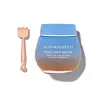What's inside
What's inside
 Key Ingredients
Key Ingredients

 Benefits
Benefits

 Concerns
Concerns

 Ingredients Side-by-side
Ingredients Side-by-side

Water
Skin ConditioningPropanediol
SolventIsodecyl Neopentanoate
EmollientPentylene Glycol
Skin ConditioningNiacinamide
SmoothingHexyldecanol
EmollientCetearyl Alcohol
EmollientXylitylglucoside
HumectantCeteth-20 Phosphate
CleansingAnhydroxylitol
HumectantEthyl Linoleate
EmollientAsiaticoside
AntioxidantAsiatic Acid
Skin ConditioningMadecassic Acid
Skin ConditioningNaringenin
Skin ConditioningCyanocobalamin
Skin ConditioningPanthenyl Triacetate
4-T-Butylcyclohexanol
MaskingHydroxyphenyl Propamidobenzoic Acid
Skin ConditioningCetylhydroxyproline Palmitamide
Skin ConditioningBisabolol
MaskingBrassica Campestris Sterols
EmollientSphingolipids
EmollientPhospholipids
Skin ConditioningEpigallocatechin Gallatyl Glucoside
AntioxidantGallyl Glucoside
AntioxidantPropyl Gallate
AntioxidantXylitol
HumectantZingiber Officinale Root Extract
MaskingStearic Acid
CleansingDicetyl Phosphate
EmulsifyingIsoceteth-20
EmulsifyingXanthan Gum
EmulsifyingTrisodium Ethylenediamine Disuccinate
Tocopherol
AntioxidantDehydroacetic Acid
PreservativeP-Anisic Acid
MaskingPhytic Acid
Sodium Phytate
Sodium Citrate
BufferingSodium Hydroxide
BufferingBenzyl Alcohol
PerfumingEthylhexylglycerin
Skin ConditioningPhenoxyethanol
PreservativeChlorphenesin
AntimicrobialWater, Propanediol, Isodecyl Neopentanoate, Pentylene Glycol, Niacinamide, Hexyldecanol, Cetearyl Alcohol, Xylitylglucoside, Ceteth-20 Phosphate, Anhydroxylitol, Ethyl Linoleate, Asiaticoside, Asiatic Acid, Madecassic Acid, Naringenin, Cyanocobalamin, Panthenyl Triacetate, 4-T-Butylcyclohexanol, Hydroxyphenyl Propamidobenzoic Acid, Cetylhydroxyproline Palmitamide, Bisabolol, Brassica Campestris Sterols, Sphingolipids, Phospholipids, Epigallocatechin Gallatyl Glucoside, Gallyl Glucoside, Propyl Gallate, Xylitol, Zingiber Officinale Root Extract, Stearic Acid, Dicetyl Phosphate, Isoceteth-20, Xanthan Gum, Trisodium Ethylenediamine Disuccinate, Tocopherol, Dehydroacetic Acid, P-Anisic Acid, Phytic Acid, Sodium Phytate, Sodium Citrate, Sodium Hydroxide, Benzyl Alcohol, Ethylhexylglycerin, Phenoxyethanol, Chlorphenesin
Glycerin
HumectantPropanediol
SolventCaprylic/Capric Triglyceride
MaskingSodium Acrylates Copolymer
Hydrogenated Polyisobutene
EmollientWater
Skin ConditioningPanthenol
Skin ConditioningPhospholipids
Skin ConditioningLeuconostoc/Radish Root Ferment Filtrate
AntimicrobialHelianthus Annuus Seed Oil
EmollientPolyglyceryl-10 Stearate
Skin Conditioning3-O-Ethyl Ascorbic Acid
Skin ConditioningIsosorbide Dicaprylate
Skin ConditioningBenzyl Alcohol
PerfumingCocodimonium Hydroxypropyl Silk Amino Acids
Skin ConditioningMarrubium Vulgare Meristem Cell Culture
Skin ProtectingButylene Glycol
HumectantCaprylhydroxamic Acid
Hydrolyzed Verbascum Thapsus Flower
AntioxidantAvena Sativa Meristem Cell Extract
HumectantSodium Gluconate
Skin ConditioningSodium Lactate
BufferingRumex Occidentalis Extract
Skin ConditioningNonapeptide-1
Skin ConditioningDextran
Xanthan Gum
EmulsifyingSodium Hyaluronate
HumectantPhenethyl Alcohol
MaskingPotassium Sorbate
PreservativeCaprylyl Glycol
EmollientGlycerin, Propanediol, Caprylic/Capric Triglyceride, Sodium Acrylates Copolymer, Hydrogenated Polyisobutene, Water, Panthenol, Phospholipids, Leuconostoc/Radish Root Ferment Filtrate, Helianthus Annuus Seed Oil, Polyglyceryl-10 Stearate, 3-O-Ethyl Ascorbic Acid, Isosorbide Dicaprylate, Benzyl Alcohol, Cocodimonium Hydroxypropyl Silk Amino Acids, Marrubium Vulgare Meristem Cell Culture, Butylene Glycol, Caprylhydroxamic Acid, Hydrolyzed Verbascum Thapsus Flower, Avena Sativa Meristem Cell Extract, Sodium Gluconate, Sodium Lactate, Rumex Occidentalis Extract, Nonapeptide-1, Dextran, Xanthan Gum, Sodium Hyaluronate, Phenethyl Alcohol, Potassium Sorbate, Caprylyl Glycol
 Reviews
Reviews

Ingredients Explained
These ingredients are found in both products.
Ingredients higher up in an ingredient list are typically present in a larger amount.
Benzyl Alcohol is most commonly used as a preservative. It also has a subtle, sweet smell. Small amounts of Benzyl Alcohol is not irritating and safe to use in skincare products. Most Benzyl Alcohol is derived from fruits such as apricots.
Benzyl Alcohol has both antibacterial and antioxidant properties. These properties help lengthen the shelf life of products. Benzyl Alcohol is a solvent and helps dissolve other ingredients. It can also improve the texture and spreadability.
Alcohol comes in many different forms. Different types of alcohol will have different effects on skin. This ingredient is an astringent alcohol.
Using high concentrations of these alcohols are drying on the skin. They may strip away your skin's natural oils and even damage your skin barrier. Astringent alcohols may also irritate skin.
Other types of astringent alcohols include:
According to the National Rosacea Society based in the US, you should be mindful of products with these alcohols in the top half of ingredients.
Any type of sanitizing product will have high amounts of alcohol to help kill bacteria and viruses.
Learn more about Benzyl AlcoholPhospholipids are naturally found in our skin as they are the main component of cell membranes. Phospholipids have humectant, emollient, antioxidant properties.
Phospholipids are complex lipids that contain glycerin, two fatty acids, and a phosphate group. Some foods that contain phospholipids include soybeans and milk. The phospholipids found in soy come from Lecithin. This ingredient can also be synthetically created.
Due to their hygroscopic nature, they act as both humectants and emollients. Humectants draw moisture from the air to your skin, while emollients help trap moisture in.
The phospholipids in our skin can be naturally depleted. Replenishing the phospholipids in our skin can help hydrate your skin.
Studies show phospholipids display antioxidant activity and may help with reducing the signs of aging.
This ingredient is non-occlusive.
Some types of phospholipids:
Learn more about PhospholipidsPropanediol is an all-star ingredient. It softens, hydrates, and smooths the skin.
It’s often used to:
Propanediol is not likely to cause sensitivity and considered safe to use. It is derived from corn or petroleum with a clear color and no scent.
Learn more about PropanediolWater. It's the most common cosmetic ingredient of all. You'll usually see it at the top of ingredient lists, meaning that it makes up the largest part of the product.
So why is it so popular? Water most often acts as a solvent - this means that it helps dissolve other ingredients into the formulation.
You'll also recognize water as that liquid we all need to stay alive. If you see this, drink a glass of water. Stay hydrated!
Learn more about WaterXanthan gum is used as a stabilizer and thickener within cosmetic products. It helps give products a sticky, thick feeling - preventing them from being too runny.
On the technical side of things, xanthan gum is a polysaccharide - a combination consisting of multiple sugar molecules bonded together.
Xanthan gum is a pretty common and great ingredient. It is a natural, non-toxic, non-irritating ingredient that is also commonly used in food products.
Learn more about Xanthan Gum